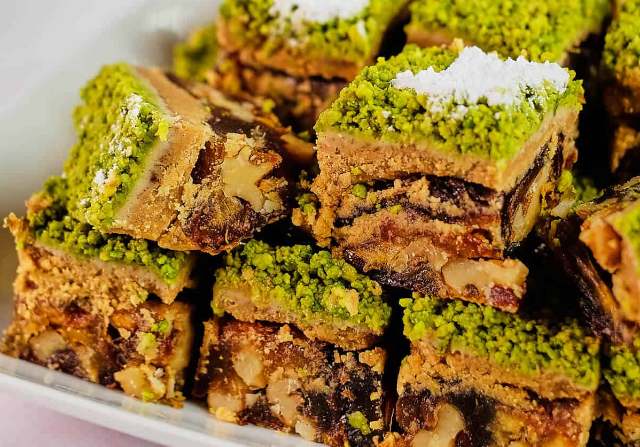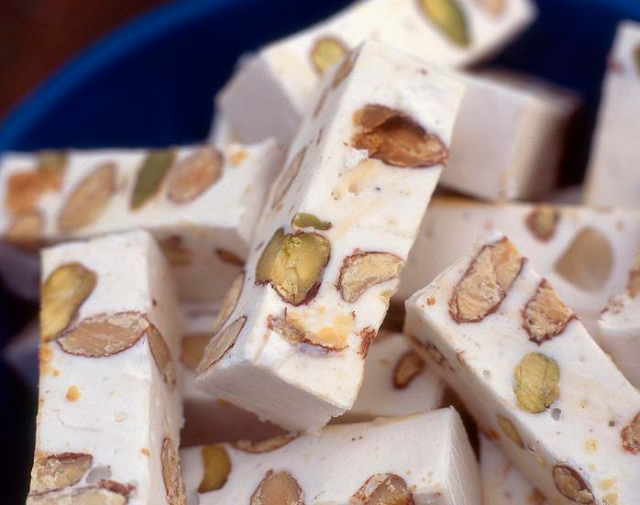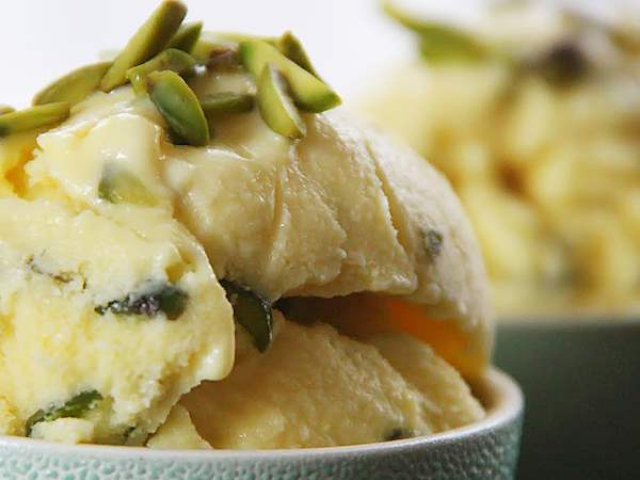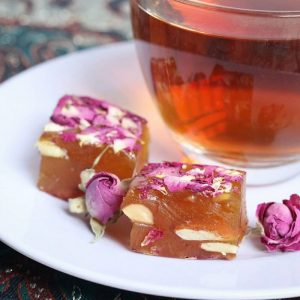Yesterday, we began our extended tour of Iranian cuisine with a look at main dishes: lots of kebabs and stews, and mountains of rice. Today, we continue our expedition to the Iranian kitchen with a look at the culture’s favourite desserts. For a nation with an austere reputation, they certainly love their sweets!
 Ranginak: Walnut-stuffed dates form the savoury-sweet stuffing layered between
Ranginak: Walnut-stuffed dates form the savoury-sweet stuffing layered between
blankets of toasted wheat flour flavoured with sugar, cinnamon and cardamon.
On our menu today:
Faloodeh: Unlike any dessert you’ve probably ever had before, this beloved concoction consists of a frozen sugar syrup infused with rose water and served over vermicelli noodles. It’s usually topped with a dash of fresh lime juice, chopped pistachios, or sweet cherry syrup. A popular street food!
Naan berenji: These rice flour-based cookies are a favourite at New Years. They are traditionally flavoured with rosewater and cardamon, and pressed into round shapes. Decorations may include poppy seeds, pistachios, or barberries. Serve them with a cup of tea or coffee.
Nogah: A Nougat made with a base of sugar and beaten egg whites, this ultra-sweet nibble is made in loaves, and cut into bars. It may contain additions such as almonds or other nuts, or dried fruits.

Halva: This term covers a whole spectrum of dense, bar-shaped sweets made with flour, lentils, butter, nuts, rose water, and saffron, in varying quantities. It’s popular all over Iran. Not to be confused with…
Halva ardeh: A popular anytime snack, this rich bar consists primarily of sugar and ground sesame seeds or tahini. It traditionally comes with Pistachio slivers on top and may include embedded whole Pistachios. It’s often eaten for breakfast.
Ranginak: Walnut-stuffed dates form the savoury-sweet stuffing for this traditional Iranian dessert. They’re layered between blankets of toasted wheat flour flavoured with sugar, cinnamon and cardamon. The whole assemblage is pressed into a round cake pan and chilled before serving.
Qottab: Qottabs are pockets of wheat flour dough stuffed with sweet almond or walnut fillings flavoured with with cinnamon, rose water, cardamom, and orange blossom essence.

They’re usually made very small, similar in size to a New Orleans Beignette. And, again similar to a Beignette, they’re generously dusted with powdered sugar.
Noghl: Roasted Almonds are immersed in a hot sugar syrup enhanced with rosewater and allowed to cool, forming a sweet crust. The resulting snowy-white morsels are considered good luck and are always found at Iranian weddings. But they’re also commonly consumed as a snack with a cup of tea.
Bastani sonnati: The Iranian love affair with saffron even extends to ice cream! Not an ancient creation, Bastani sonnati was invented by Akbar Mashti, reputed to be Tehran’s first ice cream vendor, about a hundred years ago.

It’s made from cream, frozen custard, and sliced pistachios, flavoured with rosewater and, of course, saffron. It’s usually served scooped into bowls or between two plain wafer cookies – as the Iranian ice cream sandwich ‘bastani nooni’.
Masghati: This famous Iranian desert treat (see photo, top of page) will remind you of Turkish delight – and that’s no coincidence. The jelly-like base is made with milk or water, sugar, and starch. The potential colours and flavours – contributed by various spices, essences and fruits – are endless. Pomegranate seeds and chopped nuts are popular inclusions.
Didn’t I tell you Iranians love their sweets?
You can easily Google recipes for any of the above Iranian deserts. Some require a certain amount of care and involve long preparation times, but they’re worth it! Tomorrow, we’ll take a look into the traditional Iranian bread basket – probably the most varied and intriguing of any cuisine we’ve visited yet!
~ Maggie J.

